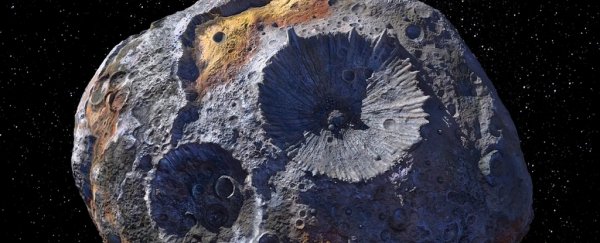Roughly two to three times Earth's distance from the Sun, in the Asteroid Belt that lies between Mars and Jupiter, 16 Psyche makes its home. This giant metal asteroid is one of the most massive objects in the Asteroid Belt, categorised as a minor planet.
Astronomers think that 16 Psyche is the exposed core of a full planet that didn't make it all the way, and we're itching to know more about it. NASA will be sending a probe to check it out in the next few years, and in the meantime, scientists are working to glean what they can from Earth.
Now, for the first time, 16 Psyche has been studied in ultraviolet wavelengths using the Hubble Space Telescope, revealing that, just as we thought, the dense chunk of space rock is remarkably metallic.
"We've seen meteorites that are mostly metal, but Psyche could be unique in that it might be an asteroid that is totally made of iron and nickel," said planetary scientist Tracy Becker of the Southwest Research Institute.
"Earth has a metal core, a mantle and crust. It's possible that as a Psyche protoplanet was forming, it was struck by another object in our Solar System and lost its mantle and crust."
16 Psyche is a pretty fascinating chunk of rock. It's about 226 kilometres (140 miles) across, and just a little less dense than Earth. Its composition seems to consist of somewhere between 30 to 60 percent metal, and the rest low-iron silicate.
If 16 Psyche is a protoplanetary core, it's possible such impacts stripped it of its accumulating material. Planets are thought to form when their stars are very young - possibly even in tandem - and are surrounded by a thick cloud of dust and gas. Material in this cloud starts to stick together, first electrostatically, then gravitationally as the object grows more massive.
As these bodies grow, they become hot and a bit molten, allowing material to move around. Core differentiation is the process whereby denser material sinks inwards towards the centre of the object, and less dense material rises outwards. For 16 Psyche to be a differentiated core, the protoplanet would once have had to have been much bigger than it is now.
Exactly when, and how, its outer mantle was stripped away is a bit of a head-scratcher. But Becker's team's research could be the breadcrumbs that put us on the trail to figuring it out.
"We were able to identify for the first time on any asteroid what we think are iron oxide ultraviolet absorption bands," she said. "This is an indication that oxidation is happening on the asteroid, which could be a result of the solar wind hitting the surface."
In other words, 16 Psyche is rusting. And we might be able to work out how old its surface is based on how much oxidation has occurred - which in turn could give us a timeline of when the asteroid was stripped of its outer material.
The asteroid's high reflectivity at ultraviolet wavelengths suggests that it's been a long time; usually, ultraviolet brightness is linked with space weathering. But we won't know for sure until NASA's Psyche probe reaches the asteroid sometime around 2026.
Scientists are also keen to get a closer look at 16 Psyche's composition. There's a lot of wiggle room between 30 and 60 percent metal that has made it hard to track down smaller pieces of rock that may have resulted from the impact fragmentation of the 16 Psyche's mantle.
It was once thought that the relatively metallic mesosiderite meteorites were remnants of 16 Psyche, but more recent research has found the connection weak.
The work of Becker and her team revealed a spectrum that is consistent with pure iron, but that may be misleading - as little as 10 percent iron on the surface could dominate the ultraviolet spectrum. There are also very few analogous observations of planetary surfaces in ultraviolet against which to compare the new views of 16 Psyche.
So, we obviously just have to go and check it out with an actual orbiting probe, which in turn will indicate how well we've done trying to figure out this strange object from hundreds of millions of kilometres away. Whatever we learn, it's going to be like looking at a Solar System time capsule.
"What makes Psyche and the other asteroids so interesting is that they're considered to be the building blocks of the Solar System," Becker said.
"To understand what really makes up a planet and to potentially see the inside of a planet is fascinating. Once we get to Psyche, we're really going to understand if that's the case, even if it doesn't turn out as we expect. Any time there's a surprise, it's always exciting."
The research has been published in The Planetary Science Journal.
